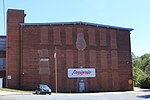Union Street North–Cabarrus Avenue Commercial Historic District
Union Street North–Cabarrus Avenue Commercial Historic District is a national historic district located at Concord, Cabarrus County, North Carolina. The district encompasses 14 contributing buildings in the central business district of Concord. It primarily includes commercial buildings in popular architectural styles including Beaux-Arts style architecture. Located in the district are the Bell and Harris-Maxwell Brothers Furniture Store (1921–1924), Yorke and Wadsworth Company Warehouse (1908–1911), Lippard and Barrier Grocery (1908–1911), Concord National Bank and Hotel Concord (1926), Star Theatre (c. 1890; 1913–1920), Cannon Building and Concord Theatre (1920–1924; 1925), and Horton Building–Commerce and Merchants Building (1952).It was listed on the National Register of Historic Places in 2003.
Excerpt from the Wikipedia article Union Street North–Cabarrus Avenue Commercial Historic District (License: CC BY-SA 3.0, Authors).Union Street North–Cabarrus Avenue Commercial Historic District
Union Street North, Concord Downtown
Geographical coordinates (GPS) Address Nearby Places Show on map
Geographical coordinates (GPS)
| Latitude | Longitude |
|---|---|
| N 35.410555555556 ° | E -80.581388888889 ° |
Address
The Bead Lady
Union Street North 1
28025 Concord, Downtown
North Carolina, United States
Open on Google Maps






